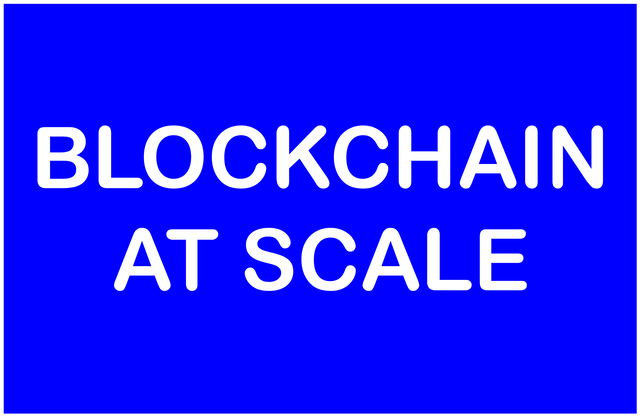With GoChain, The Future Of Blockchain No Longer Has A Slow Lane GOCHAIN 2018

For nobody is a secret that the platform of the blockchain of ethereum needs a change due to the increasing number of projects based on this digital currency, it has presented a constant growth, this put to the test capacity of scalability, also its 15 transactions per second is It is falling short, really too short for the amount that is needed due to its growth
The same programmer father of the currency vitalik buterin has referred to this problem in many press conferences, although his position to the entrance new projects for his currency is not all good, deep down he knows that a solution to this is needed problem, is not a simple problem of little weight, in reality it affects the growth of the ethereum in the future, besides showing the possibility of collapsing the ecosystem of the currency
Currently there is a long list of people and groups of entrepreneurs who have been working for several years on their projects, many with great potential, which is only slowed by the problem of slowness of the ethereum, it is like riding in your sports car very fast on a rural road full of potholes, it is a great waste to see braking so many good projects just for this problem
Many pre-sales campaigns for new assets (ICO) which offer for sale ERC20 assets (operative on the Ethereum platform) are making the need to solve this problem even stronger, the same buterin has asked the community to be more participate for the development of solutions that help solve the crisis that can be generated
The safety of the ethereum also needs a hand
Parity Wallet is one of the most important Ether portfolios in the world, last summer the most serious robbery took place on this coin, around 28 million dollars vanished from the wallets of the users, This critical failure in the currency Virtual uncovered by the portfolio created by the co-founder of Ethereum is the second critical failure, another recent failure has caused that $ 280 million in Ether are temporarily frozen.
With the growth comes the need for security with high standards of reliability, every project or company that generates constant growth will be subject to attacks on its security, it is normal throughout the world, and companies and their investors must have a backing that guarantee the assets of all
The pow system is generating certain problems
The work test (pow) is the one used for the production of new chain blocks, both the bitcoin and the ethereum work under pow, this system is the one that works the miners, which have the task of solving complicated mathematical riddles and thus generate their profits, now with the mining boom, this process is being centralized, the power of hardware and software necessary to compete in this field is skyrocketing, apart from the energy consumption for the operation of these equipment is somewhat irrational, leaving the market in the hands of large Chinese companies and leaving aside the common user
These calculations require a great amount of time and expenses, and although they are necessary for the operation and security of the currency, they are only used for that work, generating several doubts about its potential and profit.
Although this is a virtual currency, the expenditure of energy for your work is not, since a transaction in ethereum can spend the energy that an average Spanish household spends in 4 days, and the bitcoin per year consumes the same energy as all of Nigeria
It also touches the environmental problem that this generates, because that energy must be generated in some way, and are expenses that were not previously on the list, so it is urgent a measure of change to make more rational the work of these virtual currencies
Is there a solution to this looming problem? Yes, GoChain has the solution!
Some ICO projects are developing new strategies and methods to try to overcome the challenges, but few have the specialized gochain team, analyzing the fundamental failure in the ethereum, its scalability, bringing innovative solutions that will allow users to change of Ethereum to GoChain for 100 times better performance.
This characteristic of gochain is fundamental for the advance, because with its speed of transactions demonstrated of 1300 transactions per second, it leaves behind the problems generated by the more of 13 transactions per second of the ethereum, it not only solves the problem of scalability, he also gives input the emergence of new projects in the future,it's like going from walking to running in an ultimate model car, with this ability to respond is supported the functionality of the platform, which is ready to work and respond to thousands of projects that can be started, without having the risk of stagnation due to the slowness of processes.
For this part we have the solution to the scalability and slowness of the processes in the future, but there is also an advance when it comes to changing the work test system (POW) to the new reputation test system (POR) that is based on the authority test (POA)
The main and most important novelty is the social justice, because a bunch of Chinese companies are appropriating the mark of mining, a system that was born for decentralization and bring equality of growth and development is being knelt by these corporations, because they use the need for computational power and financial to leave out the common user who mines and divide the loot leaving only crumbs to the rest of the world
Taking accounts of energy expenditure, mining does not generate so much waste of energy, more than 70% goes in the process of generating blocks, so the system (POW) has proved to be very inefficient at this point, it was good for the start but it is time to implement solutions that give way to the future, and technology is available with the system (POR) that uses the gochain platform, is only migration and move into the future
with the implementation of the (POR) system a system of high energetic and excluding consumption is left behind to move to a decentralized system based on reputation, different organizations around the world can bet their reputation to confirm different types of transactions and blocks, with a system that encourages these organizations to achieve compliance with the breached, these will ensure the proper functioning of the system, apart from being distributed around the world in more than 50 countries, thus achieving greater decentralization and raising the security by reducing any attack 51% making it impossible
The gochain TestNet goes flying
In the recent test during 10 hours of work it was possible to determine the speed 100 times greater in transactions in its pilot test, now, that is only the beginning, a speed is expected in May that exceeds 10,000 tps to the future, giving the incomparable advantage of instant transactions to support the projects born and those that migrate to the platform, goodbye to the problems of scalability, no more lazy movements for your project, this is simply the door to the future
The gochain wallet is fully compatible with the ethereum allowing the migration of any project to the platform to provide the advancesand backing thereof, ensuring investment and generating a broad ecosystem without restrictions of any kind for the growth of projects and births of new ideas previously limited by the scalability resources of the ethereum ecosystem
Any application born under the protection of the gochain platform is born with the backing of the solidity given by the system, it will not have future problems that surround it, nor will it need future transformations for its protection, so it should only focus on being functional and attractive for its users
MY JOURNEY STORY
I remember sitting on a plane at the gate. The flight was supposed to take off 15 minutes ago. I was getting agitated. Then the pilot comes onto the PA system and says, "Sorry, for the delay. We are waiting on some paperwork before we can leave the gate. We should be pushing back in about 10 minutes."
Boy, was I upset. I mean, we were already 25 minutes late. And I was already on a four-hour flight from Tampa to Los Angeles and now I had to sit another 25 minutes in this tiny airline seat because of a delay in paperwork?! I want a refund!
Then it occurred to me. I am sitting here in this seat, waiting to be flown at 500 miles an hour across an entire continent in under 5 hours and I was still complaining. Let's face it. We humans don't like to wait.

"We are a nation that shouts at a microwave to hurry up."
-John Ryan
Sorry For the Delay In Your Ethereum Transaction...
One of the biggest problems with Ethereum is the slowdown in speed and transactions as more and more projects clog up the system. Many people are wondering when this problem will be solved. Now, one innovative project is proving that Etherium based projects now have a "Fast Lane" solution to their project.
Introducing GoChain. Blockchain at the speed of the future
https://gochain.io - GoChain - is a new blockchain project that is optimized for speed. Transaction will be 100 times faster as well as 1000 time more energy efficient than existing blockchain projects like Ethereum. Right now, Ethereum is designed to handle 13 transactions per second. As Ethereum scales, this transaction rate will slow down every project on this platform. Projects on GoChain, on the other hand, won't have to worry about such slow down issues.
Image Source
Introduction
- Cryptocurrency has come to stay! Remember a time when transferring money globally at an instant? Well Cryptocurrency changed that, in a fast, easy and almost stress-less way.
Smart contract is a computer protocol that digitally facilitate, verify, or enforce the performance of a contract. In times before, the performance of credible transactions was done with third parties. Well, Smart contract came to change that. Now credible transactions can be performed without third parties, and these transactions are trackable and irreversible.
As expected, cryptocurrency and smart contractors can be used potentially via the blockchain which can take almost every institution and industry to the next level. However, there are some factors hindering this vision.
The problem of blockchain is un-scalability, decentralization problem and amount of energy needed.
The Problem:
Speed and Volume
Public, decentralized cryptocurrencies are slow. Bitcoin can only process 7 transactions per second, Ethereum can only process 13 per second. Also, the time taken to verify transactions can range from several minutes to several hours depending on current volume. This is a big problem.Energy Consumption
Mining blocks uses an enormous amount of energy via a consensus algorithm known as Proof-of-Work (POW). POW requires non-trivial computational work by mining nodes which, in turn, makes it cost prohibitive for a bad actor to perform malicious acts. This computational workload requires energy. Do you know that about 3.5 million US households could be powered with the energy used to run the Bitcoin network? And that 1 million households can be powered with the energy used to run Ethereum? This is a huge amount of energy, and it is unsustainable.Decentralization
Decentralization is a central tenant of cryptocurrencies. It aims to ensure that no one company or government or person can control it. In practice however, most mining is done in China where electricity is cheapest. Up to 75% of all blocks are mined by large Chinese mining companies. This is a fact of Bitcoin Cash, Bitcoin, Ethereum and other top cryptocurrencies. Is this really decentralization?Rigid Contracts
Ethereum offers smart contracts. Smart contracts allow users to write small, unmodifiable programs that aims to ensure that all involved parties are committed to a set of rules with absolute certainty. This has a high rate of success that almost every ICO has run on Ethereum’s smart contract system in the past years.
However, are these smart contracts are really not smart. They are extremely rigid contracts that wont adapt to changes like real world contracts do. Parties involved in a contract have no ability to upgrade their contract if necessary to adjust terms or to fix bugs in contract code. There are also several successful attacks made on smart contracts, and many are public.
Previous attempts at solving the problem:
Proof-of-Work Algorithm
POW was originally invented as a means to combat spam; if the cost of sending an email is computationally expensive, then spamming would be cost prohibitive, while a normal user would still send emails for an almost free cost. This is the same concept used in cryptocurrencies to prevent malicious actions by making it prohibitively expensive to modify the blockchain. POW however, suffers from poor performance, a lack of decentralization, and excessive energy consumption.Proof-of-Stake Algorithm
The idea behind the POS is that those with the most coins in circulation have more to lose than others, so they are positioned to work in the interest of the network. This approach avoids the cost of computing hashes, however, it makes assumptions about the interests of its members being in line with the network.
Validators within the POS network are anonymous users who are identified only by their wallet address. This provides no additional accountability over POW for bad actors who can make a lot of wealth on the network. Also, transaction fees goes to those who already have the most money within the network. Lastly, the speed is only 100 transactions per seconds.Proof-of-Authority Algorithm
Proof-of-Authority is a consensus algorithm where a trusted set individuals provide all transaction processing. This trust allows transaction processing speed to improve significantly by skipping the PoW hash computation. A few networks exist but they currently only focus on private networks or do not focus on performance as a goal. Many also do not have compatibility with the Ethereum network. Also, there is a strong incentive for bribery. Another issue is that validators must post their physical address publicly, this opens potential for intimidation or physical threats. Also, most individuals lack the experience and infrastructure to run a secure transaction processing system.
The GoChain Solution
GoChain is a next generation smart contract platform. It is a standalone blockchain. It solves the scaling problem with immediacy, using an improved Ethereum codebase. GoChain currently have a working TestNet showing in excess of 1300 transactions per second ongoing with stability and has been running as high as 2400 transactions per second.
Check out the stats from a recent 10 hour test run.
Image Source
Presently, Ethereum can only process 13 transactions per second, which is the industry capacity, and the truth is that their network is at capacity. New blockchains are been built, but these wont fix the Ethereum scaling problem. Also, these new blockchains are roughly 12-24 months out. A high percentage of smart contracts are Ethereum based (over 90%) and an immediate solution to the “scalability trilema” is needed. And, that’s where GoChain comes in.
GoChain will solve the Ethereum scaling problem with immediacy, and anyone currently using Ethereum can transfer to the GoChain network seamlessly without making any code changes. And once you join the GoChain network, you get:
- 10x more decentralization: this is achieved by using the Proof of Reputation algorithm
- 100x increase in speed: with this speed, think about the boundless achievements possible on the blockchain, it definitely keeps me in awe.
- 1000x improvement in energy consumption: at this low rate of energy consumption, it means more work can be done at much more lesser energy. GoChain is indeed an improvement
Proof of Reputation (POR)
Given the need to improve the consensus algorithms, there have been several changes, from Proof of Work (POW) used by Bitcoin, where you have security because of the enormous energy and computational power needed to alterate any transaction, but at the cost of an excessive electricity consumption that limits scalability and groups of cartelized miners that make the system not fully decentralized.

Then we have Proof of Stake (POS) where validators are chosen randomly based on the amount of investment and participation they have within the network, therefore those with more coins are the guardians of the integrity of the system, because they are the ones that have more to loose if something goes wrong. Less power consumption but still the issue with centralized nodes is not solved .
On the other hand, there is the Proof of Authority consensus (POA) where trusted or authoritative persons (previously verified) provide all the processing of transactions, the problem with this protocol is that those who supply their data for verification got their privacy compromised and are exposed to attacks, also many networks that use POA do not have compatibility with Ethereum.
Finally, the team of GoChain reached a concept that has all the upsides of the previous protocols but none of their weaknesses, Proof of Reputation model (POR) allows only well known and established companys to be an authoritative node to validate transactions, companies will have unaffordable loses if they got caught cheating the system because its brand will loose its reputation and their customers will consider them not trustworthy.
Proof of Reputation; the protocol and it’s benefits:
GoChain intends to solve the problem by changing the consensus algorithm from Proof of Work (POW) to Proof of Reputation (POR). POR is an upgraded, stronger, and more secure form of Proof of Authority (POA).
In POA, transactions are approved by accounts known as validators. POA is employed in private networks and a few companies that have adopted, by using individuals as the validators, in which the identities of the individuals are made a public information, thus making the identities at stake, in exchange these individuals are rewarded and monetarily incentivized to process transactions. Making the identities of the individuals a public information is meant to try to dissuade them from being bad actors as this would damage their reputation. However, how far do you think this would go if the value of the network persuades the individuals to cheat?
This is the main reason behind GoChain’s POR. The POR uses companies as validators not individuals. A company with a reputation will definitely have a lot more to lose than an individual. A company caught cheating would be risking its reputation, the reputation of its officers, shareholders and even it’s entire market cap.
GoChain takes it a step further by planning to use 50 companies in 50 different countries as facilitators. This is to force decentralization. Using 50 companies would ensure a perfect decentralization, thus making the network very very difficult to compromise. GoChain also ensured that no one government, like the United States or China, can come in to take over the network by spreading the nodes geographically.
How will the validators be chosen?
GoChain will initially choose the validators and then selection of the validators would be done by the network.What kind of companies will they be?
Venture backed startups with a burn rate, VC partners, angel investors, and new product or service are the kind of companies to be choosed. The reason for choosing these kind of companies is that these companies would have a huge incentive to maintain the network integrity, so as their market cap and integrity remain safe.How does GoChain plan to achieve 1300+ transactions per seconds?
GoChain is solving this partially by moving to POR and by dealing with the large amounts of data in ways that allow for much faster speeds. The data storage issue alone at 1300 transactions per second produces 0.7 gigabytes a data an hour. However, any offcahin solutions such as Raiden or Plasma would be able to work on top of GoChain to achieve a faster speed.The energy Consumption Issue
By switching to POR, energy utilization needed to process the blocks is decreased considerably.
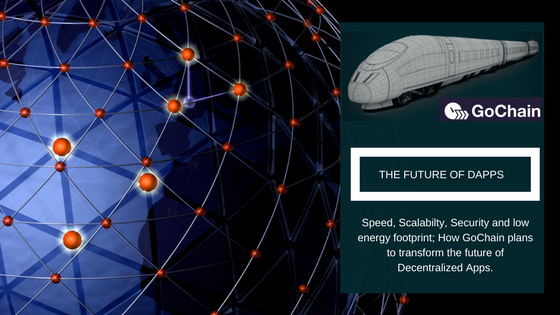.png)
THE RISE OF DECENTRALIZED APPLICATIONS
Beside digital currencies, "smart contracts and decentralized apps (Dapps)" have grown to become two of the most promising applications of the blockchain technology. Dapps were made popular by the Ethereum Network, a platform designed to provide a framework and infrastructure for building and deploying decentralized applications. Today, Dapps continue to generate a lot of enthusiasm and support from different sectors.
WHY DECENTRALIZED APPS?
The promise of better security, lack of middlemen, elimination of single point of failure, speed and efficiency has far reaching implications. A lot of organizations have began conducting extensive research on how distributed apps can impact their industries and lead to the next innovation. This is shown in the growing size of the Enterprise Ethereum Alliance, a platform which allows a number of fortune 500 companies, startups, tech vendors to learn, and build upon Ethereum’s blockchain technology.
THE STATE OF DAPPS WITH ETHEREUM
Without a doubt, Ethereum is a pioneer in the Decentralized App space, but it has suffered some setback in recent times, firstly, due to vulnerability in the network's security and also, it's limited ability to scale.
In 2016, the Ethereum network suffered a major attack which brought the issue of security to the fore. Not only was beefing up the network's security the only concern at this point, the developers were also searching for solutions to it's scalability problem. The Ethereum network is capable of conducting an approximated 13 transactions per second, and the network continues to witness a growing number of app deployment. This poses an immediate problem and the network is bound to become inefficient under serious load.
Beside security and scaling, excessive energy consumption (similar to other crypto networks) and the centralization of mining nodes in a few hands was technically defeating the true purpose of decentralization and making it unattractive. As digiconomist.net pointed out, Ethereum consumed an estimated 17.92TWh which is at par with Iceland's energy demand (Note that Bitcoin consumes higher). In a world steering towards energy efficiency, this should be a major concern.
Also, according to the developer's at Gochain, a very few number of Chinese companies control up from 70 - 80% of crypto mining (including Ethereum mining). This should also be a major source of worry for a supposedly "decentralized" platform whose aim is to discourage the centralization of power.
HOW GOCHAIN PLANS TO BE DIFFERENT?
For "decentralized apps" to grow to it's full potential, it's important to solve the main problems revolving around security, scalability, energy efficiency and concentration of power in a few hands. These were the goals of the developers of GoChain.
Gochain is proclaimed to be the next generation blockchain. It offers an improvement over Ethereum's codebase with focus being on enhancing scalability immediately, increasing security, reducing energy footprint and making the blockchain truly decentralized. The platform currently has a working prototype capable of handling as high as 1300 transactions per second as against Ethereum's 13 transactions per second.
THE PROOF-OF-REPUTATION ADVANTAGE
Gochain dumps the energy demanding Proof-of-Work (POW) consensus algorithm for Proof of Reputation (POR), a hybrid of Proof-of -Authority(POA) which offers more security and lesser energy demand. With POR, transactions are validated by approved accounts called validator. These validators, set to be 50 in number, will be initially selected by the GOChain developers from 50 different countries. It is believed that the geographical distribution will balance the spread of power and deter attack on the GoChain network. It will also make it less prone to a shut down due to aggressive acts from a single government.
REPUTATION MAKES THE DIFFERENCE
The validators' identity will be publicly declared and the responsibility for subsequent selections will be handed over to the GoChain network.
Validators are incentivized to process transactions while putting their hard earned reputation on the line. To make this more effective, only companies (like venture backed startups, VC) will be allowed to become validators as they have more at stake when it comes to reputation. This will bring a lot of sanity to the network.
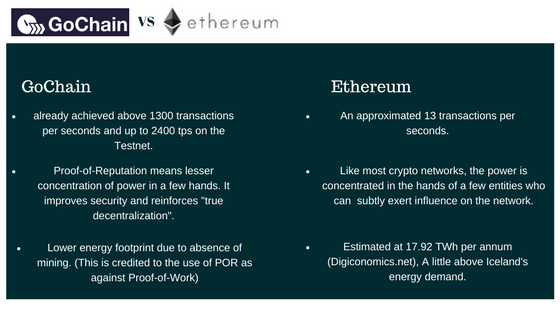.png)
The adopted POR is also envisaged to help solve scaling problem along with the ability to integrate off-chain solutions like raiden or Plasma. Not only is POR expected to help with scaling and security but it will also help reduce the energy demand for processing blocks to a large extent making the network greener.
The Team
Led by CEO Jason Dekker & Chief Software Architect Travis Reeder, the team is a highly experienced group of successful tech founders and software engineers who have built their careers on constructing high scale distributed cloud systems, so they not only know what they're doing they know what their potential clients are doing and that is the key to building successful relationships with enterprise. Their team have achieved milestone developer contributions between them including Ben Johnson's BoltDB & Jordan Krage's involvement with the [Golang] dmt, Dep . Supported by Brooke Hanson's social media expertise, their campaign and comms are clear, concise and matter of fact. A high end team of advisers ensures that their reach into the space is well rounded (and I imagine) comes under tough scrutiny where required.
Between them they have decades of experience in diverse fields ranging from hedge fund management to software development to cyber security. Rest assured they are very competent.
GoChain Medium Test Result Publication
For more information about the gochain project you can visit its website here
You can also watch his introductory video
More Information & Resources:
GoChain Website
GoChain WhitePaper
GoChain Telegram
GoChain Telegram Announcement
GoChain GitHub
GoChain Reddit
GoChain BitcoinTalk
GoChain Twitter
GoChain Facebook
GoChain Medium
GoChain Crunchbase
This is a submission to the @originalworks contest here
Gochain2018

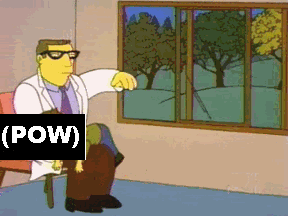.gif))
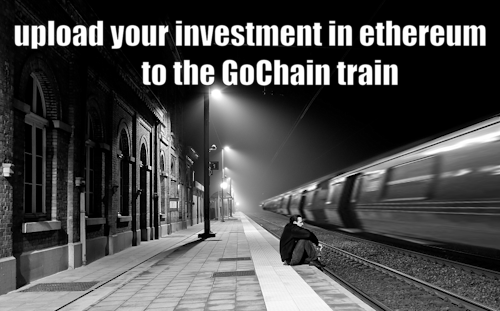)




